Multiple dialog scope issue on the PC
-
I'm having an issue with WebDialogs, that is only misfiring on PC's, Mac is okay.
Any help would be greatly appreciated!What I have is this:
$dialog1 = nil class Dialog1 def release () if ( @dialog and @dialog.visible? ) @dialog.close() end # if end # release def callback(data) @dialog.execute_script("document.forms.control.fieldx.value = '#{data}'") @dialog.execute_script("requery()") end # callback def outbound(selected) goDialog2(selected,self) end # outbound def initialize() @dialog = nil begin @dialog = UI;;WebDialog.new() @dialog.show_modal { @dialog.add_action_callback("outbound") {|d,p| outbound(p)} @dialog.execute_script("requery()") } # show rescue SystemExit # clean exit end # begin end # initialize end # Dialog1 Class def goDialog1 () if ( $dialog1 ) $dialog1.release end # if $dialog1 = Dialog1.new() end # goDialog1 $dialog2 = nil class Dialog2 def release () if ( @dialog and @dialog.visible? ) @dialog.close() end # if end # release def returnto1 (data) @dialog.close() @callingmodule.callback(data) end # returnto1 def initialize (selected,callingmodule) @callingmodule = callingmodule @dialog = UI;;WebDialog.new() @dialog.show_modal { @dialog.add_action_callback("done") {|d,p| returnto1(p)} } # show end # initialize end # Dialog2 Class def goDialog2 (selected,callingmodule) if ( $dialog2 ) $dialog2.release end # if $dialog2 = Dialog2.new(selected,callingmodule) end # goDialog2Full disclosure: I freely admit I could be screwing something up, not following best practices!
But I've found this to work and be nicely stable on the Mac.
I use a global variable for each dialog class, so that if the user clicks the same button, there isn't a second instance of the same dialog (hence the .release method).
But the primarily dialog is dialog1, which then calls dialog2 (while dialog1 is still up and displayed).
User makes a selection in dialog2, which then closes, and dialog1 is updated with what they chose.
So I accomplish this by passing "self" to dialog2, which can then use that to pass back the selection.So hopefully clearer still, the call path would be:
goDialog1, Dialog1::initialize, Dialog1::outbound,
goDialog2, Dialog2::initialize, Dialog2::returnto1, Dialog1::callback
right?
only, no. On the PC, it all works great, the first time.
After the first time, all the calls to @dialog for dialog1 just fail.
So if the user clicks again, outbound still fires, dialog2 still comes up, and user is still able to make a selection,
and Dialog1::callback still fires. But inside Dialog1::callback, anything involving @dialog just stops cold, no error message, no value returned, nothing.Hopefully makes sense?
Thanks again for any help!--J
-
Things "stop cold" because "modal" has different meanings on PC, than on Mac.
On Mac "modal" means "always on top of the application window."
On PC, child windows must always be on top of their owner window.
On the PC, "modal" creates a blocking window that seizes focus, and must be closed before any other window (including it's owner window,) can receive focus.The API dictionary should say his, doesn't it ?
What we usually do it this:
RUBY_PLATFORM =~ /(darwin)/i ? @dialog.show_modal() : @dialog.show()Also.. last I knew the block arguments for the two
showmethods (and theset_on_closemethod,) did not work on the Mac, but do on the PC.
-
@honkinberry said:
I use a global variable for each dialog class
Convert it into an class or instance variable within your own namespace. Never any need for globals.
-
Thanks guys as always!
I'll get to replacing the global variable in a minute. But for the quick change, I switched it to Modeless, but still the same issue.
You can see that dialog2 is closing, and then calling back to dialog1.
Yet in Dialog1.callback, the execute_script calls just fail, without any error or anything (even a execute_script("alert(0)") produces nothing. I can do a @dialog.close oddly enough, but apparently nothing else! What could be going wrong?$dialog1 = nil class Dialog1 def callback(data) @dialog.execute_script("document.forms.control.fieldx.value = '#{data}'") # doesn't fire second time @dialog.execute_script("requery()") # doesn't fire second time # @dialog.close # this will fire! end # callback def outbound(selected) goDialog2(selected,self) end # outbound def initialize() @dialog = nil begin @dialog = UI;;WebDialog.new() @dialog.show { @dialog.add_action_callback("outbound") {|d,p| outbound(p)} @dialog.execute_script("requery()") } # show rescue SystemExit # clean exit end # begin end # initialize end # Dialog1 Class def goDialog1 () $dialog1 = Dialog1.new() end # goDialog1 $dialog2 = nil class Dialog2 def returnto1 (data) @dialog.close() @callingmodule.callback(data) end # returnto1 def initialize (selected,callingmodule) @callingmodule = callingmodule @dialog = UI;;WebDialog.new() @dialog.show_modal { @dialog.add_action_callback("done") {|d,p| returnto1(p)} } # show end # initialize end # Dialog2 Class def goDialog2 (selected,callingmodule) $dialog2 = Dialog2.new(selected,callingmodule) end # goDialog2 -
To enable script debugging in embedded IE you need to enable it first.
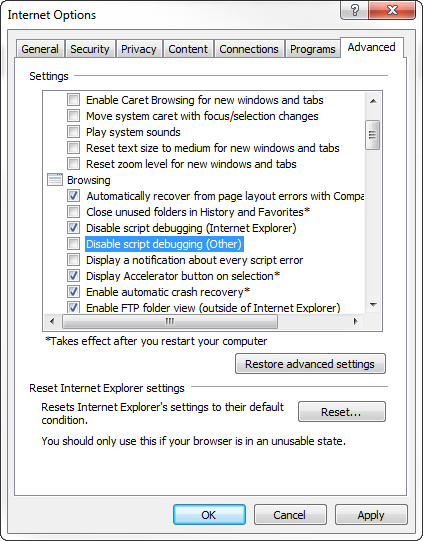
See if that yields any JS errors.
Btw, you have many methods with a space before the argument list - ie:
method (arguments). It's something that can cause unexpected problems and I assume you're getting warnings about it. -
I turned on the script debugging, still nothing.
But I've also narrowed down to the problem, this is so strange, now I know it's something simple, must be with the HTML or something.But check this:
class Dialog1 def outbound(selected) @dialog.execute_script("alert(0)") # fires the first time, that's it puts "firing" # fires every time end # outbound def initialize() @dialog = nil begin @dialog = UI;;WebDialog.new() @dialog.show { @dialog.add_action_callback("outbound") {|d,p| outbound(p)} @dialog.execute_script("requery()") } # show rescue SystemExit # clean exit end # begin end # initialize end # Dialog1 Class def goDialog1 () $dialog1 = Dialog1.new() end # goDialog1When a user clicks on the button, window.location=skp fires, Ruby fires back that execute_script, I get the Javascript alert... but only once! I can keep clicking that button, and Ruby Console shows "firing", but nothing to the dialog.
So somehow my connection back to the DOM is lost, right?
I upgraded to IE10, thinking that might be it. Nope.
It has to be something simple, right?--J
-
Ugh, I think I got it.
With javascript:void(0) in the web dialog, everything after that point kills the Ruby link to the DOM.
Any, uh, reason for this bug?
I'm going to be in Boulder in a couple weeks, who's desk shall I place a doggie turd on?
(kidding)
(sort of)--J
-
I am under the impression that javascript
%(#8000BF)[**alert()**](at least under MSIE js,) must be called from WITHIN a javascript function.So
@dialog.execute_script("alert(0)")should not work.BUT .. if you had a javascript function in the HTML file:
<script> function mbox(arg) { alert(arg); } </script>then from Ruby, calling:
@dialog.execute_script("mbox('Ruby method outbound called.');")
might work better.But of course you can use Ruby-side messagebox from within the
outbound()method, thus:
UI.messagebox('Ruby method outbound called.')
-
What are you attempting to do in simple steps (psuedocode or outline form) ?
Why do you need to complicate what you are doing by creating a "wrapper" class, that wraps an
UI::WebDialoginstance inside it ?Are you trying to create a dialog singleton class ?
-
@dan rathbun said:
I am under the impression that javascript
%(#8000BF)[**alert()**](at least under MSIE js,) must be called from WITHIN a javascript function.I've not had problems calling alert. Don't see why it should have to be wrapped within a function.
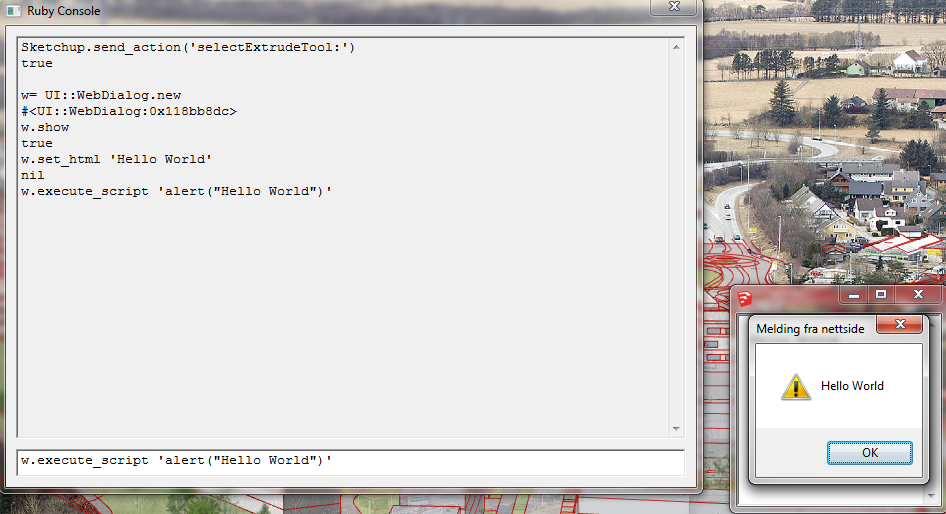
Also, this works:
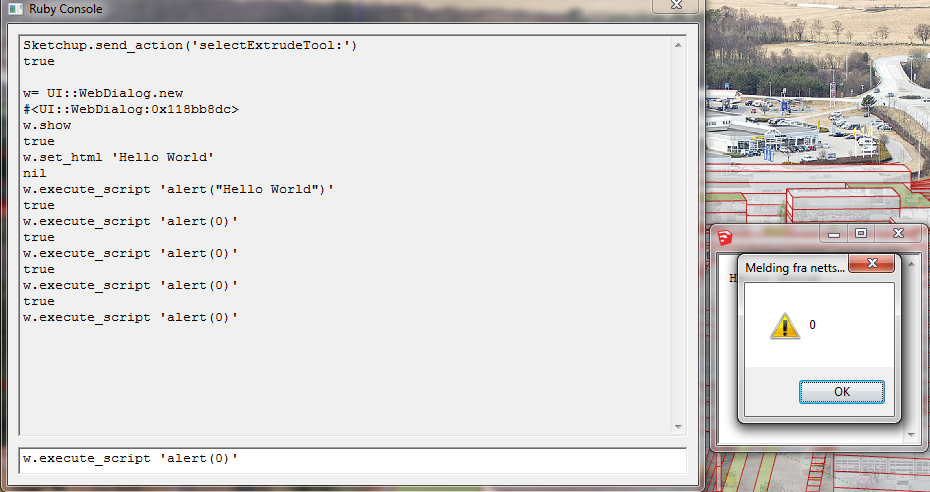
Something else seem to be amiss.
-
I got it to work, the issue is the "javascript:void(0)"
As for why I'm wrapping a dialog in a class, it's for Mac compatibility (and generally seems a good idea). But since they are modeless on the Mac, it's the only way I could come up with nicely handling the dialog box instances and communication between them. Also I generally try to Class everything, whether Ruby or PHP or Javascript.
As for the alert calls, ThomThom is right. Not only can you call "alert(0)" just about anywhere in any method, it's the fastest and easiest way I know of testing Javascript and Ruby->Javascript communication. Particularly as this is the issue at hand, thank god I don't even have to pass a string to Javascript alert, it's just totally my BFF in that manner.
But back to the issue at hand, if you have this in a WebDialog html:
<a href="javascript:void(0)" onclick="window.location='skp;done'">Click Me!</a>That works on a Mac, but on a PC, scope returns to Ruby, but Ruby is unable to access any dialog box elements, the DOM is completely gone. The only thing I've been able to do with the dialog is to close it. You can keep clicking the link, and Ruby will still get focus, but get_element_value and execute_script fail without any error.
So then this works:<a href="#" onclick="window.location='skp;done'">Click Me!</a>Which is bad programming form.
See, I don't know, this discussion.I did originally find this topic:
http://sketchucation.com/forums/viewtopic.php?f=180&t=25252
But I had read it wrong, I thought it was the lack of javascript:void(0) that was killing his.So to repeat my question -- why on Earth would "javascript:void(0)" kill Ruby's access to the DOM?
That just seems such an egregious bug.
I'm going to be in Boulder in 3 weeks, so I'd like to personally thank whichever programmer is responsible for this. In a friendly way of course.
--J
-
Instead of returning void, what if you prevent the event from bubbling further. That's what I do.
Also, instead of a class in a class, why not subclass?
I'll look further when I get home. Not at my computer to test right now.
Sent from my LT25i using Tapatalk 2
-
Why use a <A> element ?
Just make it a <DIV> element, which can also have onclick events.
-
Yes, there's plenty of ways around it.
But there's also nothing inherently wrong with having a link with 'javascript:void(0)' as the href, is there?
At least, in the sense of best programming practices.
In fact, it is, without fail, the best recommended practice.
So, my question remains -- why is it that every Sketchup developer in the world has to be careful to not accidentally follow best HTML practices, instead of one programmer in Boulder correcting what is ostensibly a single errant line of code?--J
-
@honkinberry said:
In fact, it is, without fail, the best recommended practice.
In terms of a JS application?
It's not in terms of website development - as then the href should be a working fallback in case of JS not being enabled. Which is why the onclick event should prevent bubbling.
None the less - that's straying besides the point.
Can you provide a complete working sample where your callbacks fail?
-
@honkinberry said:
But back to the issue at hand, if you have this in a WebDialog html:
> <a href="javascript:void(0)" onclick="window.location='skp;done'">Click Me!</a> >That works on a Mac, but on a PC, scope returns to Ruby, but Ruby is unable to access any dialog box elements, the DOM is completely gone. The only thing I've been able to do with the dialog is to close it. You can keep clicking the link, and Ruby will still get focus, but get_element_value and execute_script fail without any error.
I cannot reproduce this. (Windows 7, IE10)
wd.rb
<span class="syntaxdefault"></span><span class="syntaxcomment"># load 'c;/wd.rb'<br /># Example.test_void<br /></span><span class="syntaxdefault">module Example<br /> def self</span><span class="syntaxkeyword">.</span><span class="syntaxdefault">test_void<br /> path </span><span class="syntaxkeyword">= </span><span class="syntaxdefault">File</span><span class="syntaxkeyword">.</span><span class="syntaxdefault">dirname</span><span class="syntaxkeyword">(</span><span class="syntaxdefault">__FILE__</span><span class="syntaxkeyword">)<br /> @</span><span class="syntaxdefault">dialog </span><span class="syntaxkeyword">= </span><span class="syntaxdefault">UI</span><span class="syntaxkeyword">;;</span><span class="syntaxdefault">WebDialog</span><span class="syntaxkeyword">.new()<br /> @</span><span class="syntaxdefault">dialog</span><span class="syntaxkeyword">.</span><span class="syntaxdefault">set_file</span><span class="syntaxkeyword">( </span><span class="syntaxdefault">File</span><span class="syntaxkeyword">.</span><span class="syntaxdefault">join</span><span class="syntaxkeyword">(</span><span class="syntaxdefault">path</span><span class="syntaxkeyword">, </span><span class="syntaxstring">'sample.html'</span><span class="syntaxkeyword">) )<br /> @</span><span class="syntaxdefault">dialog</span><span class="syntaxkeyword">.</span><span class="syntaxdefault">show </span><span class="syntaxkeyword">{<br /> @</span><span class="syntaxdefault">dialog</span><span class="syntaxkeyword">.</span><span class="syntaxdefault">add_action_callback</span><span class="syntaxkeyword">(</span><span class="syntaxstring">"done"</span><span class="syntaxkeyword">) { |</span><span class="syntaxdefault">wd</span><span class="syntaxkeyword">, </span><span class="syntaxdefault">param</span><span class="syntaxkeyword">| </span><span class="syntaxdefault">p param </span><span class="syntaxkeyword">}<br /> } </span><span class="syntaxcomment"># show<br /> </span><span class="syntaxkeyword">@</span><span class="syntaxdefault">dialog<br /> end<br />end</span>sample.html
<span class="syntaxdefault"></span><span class="syntaxkeyword"><!</span><span class="syntaxdefault">DOCTYPE html</span><span class="syntaxkeyword">><br /><</span><span class="syntaxdefault">html</span><span class="syntaxkeyword">><br /><</span><span class="syntaxdefault">body</span><span class="syntaxkeyword">><br /><br /><</span><span class="syntaxdefault">p</span><span class="syntaxkeyword">><br /> <</span><span class="syntaxdefault">a href</span><span class="syntaxkeyword">=</span><span class="syntaxstring">"javascript;void(0)" </span><span class="syntaxdefault">onclick</span><span class="syntaxkeyword">=</span><span class="syntaxstring">"window.location='skp;done@HelloWorld'"</span><span class="syntaxkeyword">></span><span class="syntaxdefault">Click Me</span><span class="syntaxkeyword">!</</span><span class="syntaxdefault">a</span><span class="syntaxkeyword">><br /></</span><span class="syntaxdefault">p</span><span class="syntaxkeyword">><br /><br /><</span><span class="syntaxdefault">p</span><span class="syntaxkeyword">><br /> <</span><span class="syntaxdefault">a href</span><span class="syntaxkeyword">=</span><span class="syntaxstring">"#" </span><span class="syntaxdefault">onclick</span><span class="syntaxkeyword">=</span><span class="syntaxstring">"alert(document.body.innerHTML)"</span><span class="syntaxkeyword">></span><span class="syntaxdefault">innerHtml</span><span class="syntaxkeyword"></</span><span class="syntaxdefault">a</span><span class="syntaxkeyword">><br /></</span><span class="syntaxdefault">p</span><span class="syntaxkeyword">><br /><br /></</span><span class="syntaxdefault">body</span><span class="syntaxkeyword">><br /></</span><span class="syntaxdefault">html</span><span class="syntaxkeyword">> </span><span class="syntaxdefault"></span>
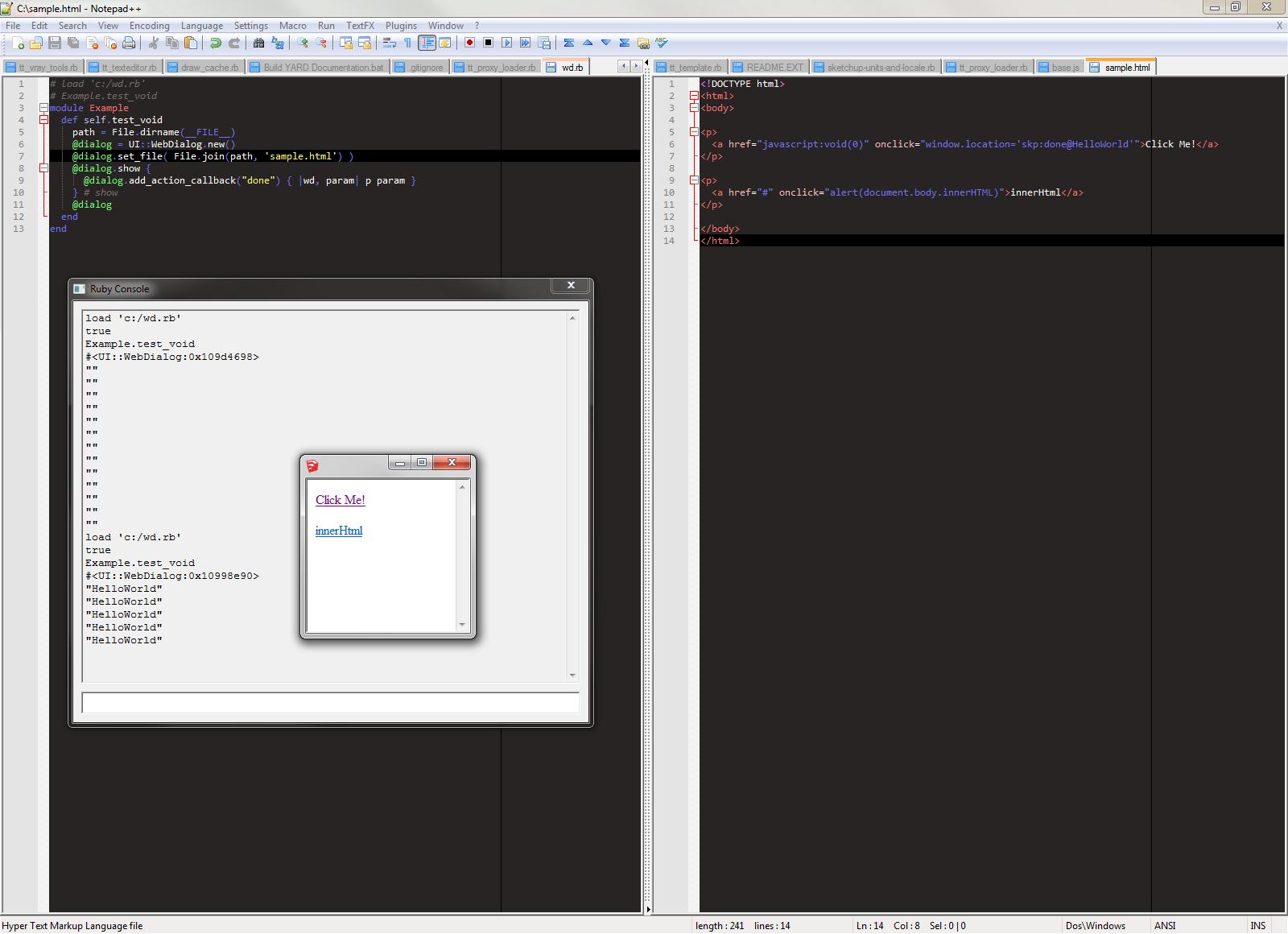
-
oh... wait... I didn't try
get_element_valueandexecute_script. -
Have you considered setting and using an enduring
@@dialograther than the instance variable@dialog?
Untested, just a thought... -
Ah. Now I can reproduce it.
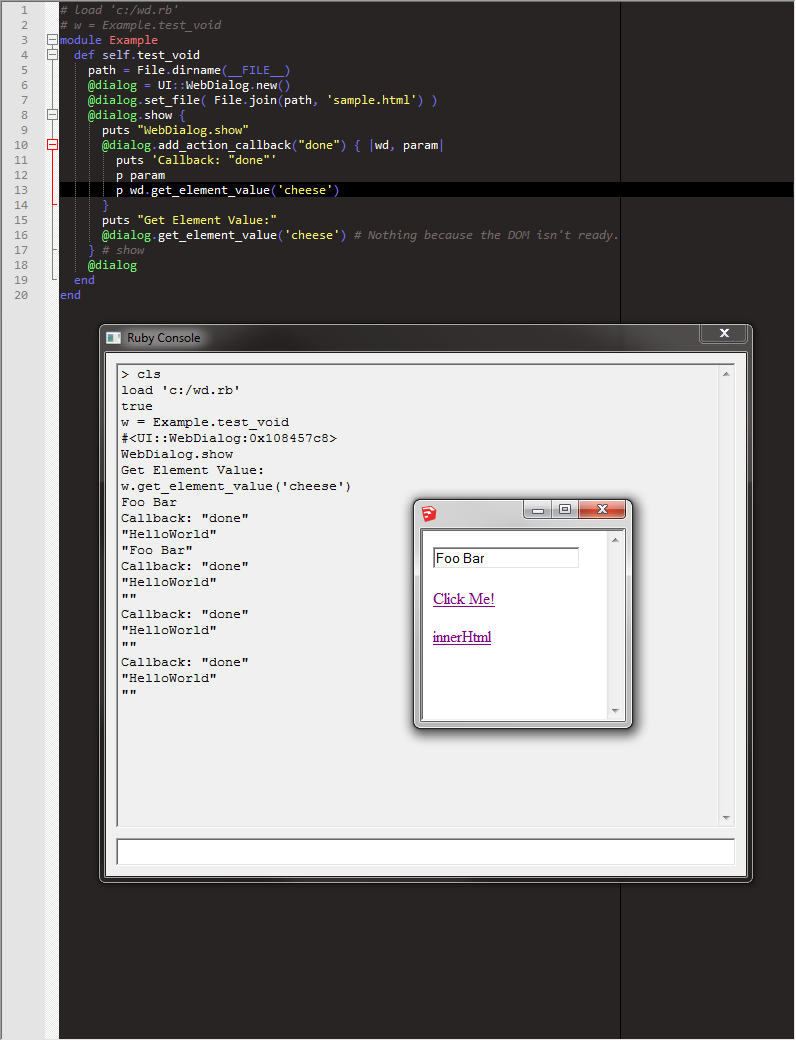
Very strange indeed.
However, I've never seen anyone using
javascript:void(0)instead of preventing the event from bubbling. First time I heard of this issue.If you don't use a framwork like jQuery you have to account for old IE's weirdness:
http://www.quirksmode.org/js/events_order.html#link9 -
Actually, you just need to
return falsefrom theonclickevent.<span class="syntaxdefault"></span><span class="syntaxkeyword"><!</span><span class="syntaxdefault">DOCTYPE html</span><span class="syntaxkeyword">><br /><</span><span class="syntaxdefault">html</span><span class="syntaxkeyword">><br /><</span><span class="syntaxdefault">body</span><span class="syntaxkeyword">><br /><br /><</span><span class="syntaxdefault">input type</span><span class="syntaxkeyword">=</span><span class="syntaxstring">"text"</span><span class="syntaxdefault"> id</span><span class="syntaxkeyword">=</span><span class="syntaxstring">"cheese"</span><span class="syntaxdefault"> value</span><span class="syntaxkeyword">=</span><span class="syntaxstring">"Foo Bar"</span><span class="syntaxdefault"> </span><span class="syntaxkeyword">><br /><br /><</span><span class="syntaxdefault">p</span><span class="syntaxkeyword">><br /></span><span class="syntaxdefault"> </span><span class="syntaxkeyword"><</span><span class="syntaxdefault">a<br /> href</span><span class="syntaxkeyword">=</span><span class="syntaxstring">"javascript;void(0)"<br /></span><span class="syntaxdefault"> onclick</span><span class="syntaxkeyword">=</span><span class="syntaxstring">"window.location='skp;done@HelloWorld'; return false;"</span><span class="syntaxkeyword">><br /></span><span class="syntaxdefault"> Click Me</span><span class="syntaxkeyword">!<br /></span><span class="syntaxdefault"> </span><span class="syntaxkeyword"></</span><span class="syntaxdefault">a</span><span class="syntaxkeyword">><br /></</span><span class="syntaxdefault">p</span><span class="syntaxkeyword">><br /><br /><</span><span class="syntaxdefault">p</span><span class="syntaxkeyword">><br /></span><span class="syntaxdefault"> </span><span class="syntaxkeyword"><</span><span class="syntaxdefault">a href</span><span class="syntaxkeyword">=</span><span class="syntaxstring">"#"</span><span class="syntaxdefault"> onclick</span><span class="syntaxkeyword">=</span><span class="syntaxstring">"alert(document.body.innerHTML)"</span><span class="syntaxkeyword">></span><span class="syntaxdefault">innerHtml</span><span class="syntaxkeyword"></</span><span class="syntaxdefault">a</span><span class="syntaxkeyword">><br /></</span><span class="syntaxdefault">p</span><span class="syntaxkeyword">><br /><br /></</span><span class="syntaxdefault">body</span><span class="syntaxkeyword">><br /></</span><span class="syntaxdefault">html</span><span class="syntaxkeyword">></span><span class="syntaxdefault"></span>

Advertisement







